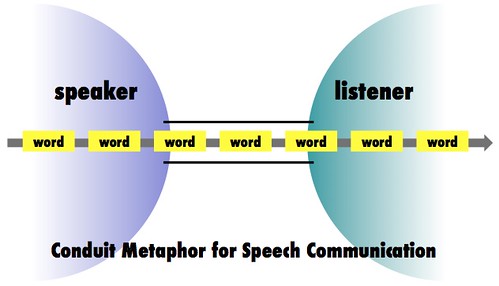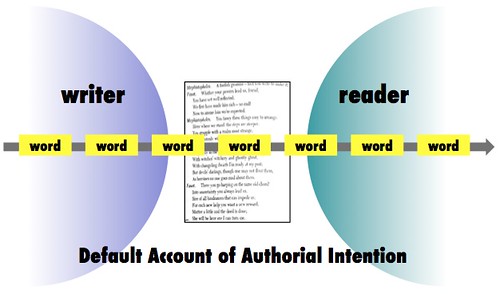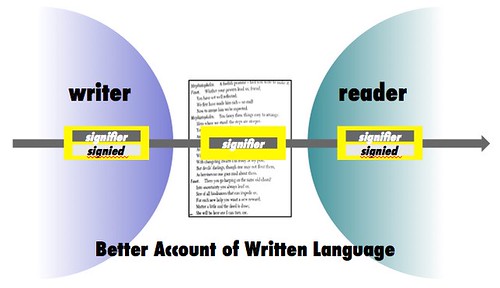In thinking about Joseph Carroll’s literary theorizing I’ve found myself thinking about authorial intention, interpretation, and the meaning of literary texts. Carroll believes that the meaning of a literary text is determinate and it was put there by the text’s author. This is a traditional position in a long and contentious discussion that has waxed and waned since the 1950s. Various positions have been argued but the profession has not arrived at a consensus on the matter.
I think it’s a hopeless discussion myself, and I don’t know whether I want to expend much effort trying to explain why it’s hopeless. But I’ve been making notes and drafting text and thought I’d post one bit. It’s about what cognitive linguists know as the conduit metaphor, a common way of talking about communication. The metaphor is pervasive, but mistaken. My sense of intentionalism is that the participants in those discussions tacitly buy into the conduit metaphor, though some of them come very close to exposing it and then disposing of it.
I remain of the view that interpreting texts is such a loose business that appeals to authorial intention are of relatively little practical value. If you will, what they can achieve is well within the “margin of error” or “fuzz factor” for interpretation in general.
The Conduit Metaphor for Speech
In 1979 Michael Reddy published an article that had wide influence on the study of metaphor in cognitive linguistics [1]. The article is based on a small group (53) of example sentences. Here are the first three (p. 166):
1. Try to get your thoughts across better2. None of Mary’s feelings came through to me with any clarity3. You still haven’t given me any idea of what you mean
Reddy’s argument is that many of our statements about communication seemed to be based on the notion of sending something (the thought, idea, feeling) through a conduit, hence he calls it the conduit metaphor. He knows that communication doesn’t work that way, but that’s not his central issue. His central concern is to detail the way we use the conduit metaphor to structure our thinking about communication.
The conduit metaphor seems to presuppose a picture – cognitive linguists would call it an image schema – that looks something like this:
We have the speaker on the left and the listener on the right. Words flow through the conduit in the middle from the speaker to the listener. Of course, when these individuals switch conversational roles the words would flow through the conduit in the opposite direction.
This picture implies that meaning is somehow physically IN those words traveling through the conduit. If that were the case then, in a practical sense, there would be no such thing as speech that you cannot understand. You may not know much about quantum mechanics, for example, but if a physicist tells you something about the subject you will understand it immediately. Why? Because the meaning is physically in the words. Similarly, someone might tell you a story in Mandarin, a language you’ve never heard – no problem! The story makes perfect sense. Why? Because the meaning is right there in the sounds.
Language doesn’t work like that. Words have two aspects: 1) the signifier (in one standard terminology) is the physical object that is spoken and heard, while 2) signified is the meaning. It is only the signifiers that physically pass from one person to another in speaking:
Where does the listener get that signified? She supplies it herself, automatically and without effort. Unless of course the speech signal is garbled or she doesn’t know the meaning of the word. In such cases she’ll ask for clarification: What’d you say? I don’t understand. And so conversations go, back and forth.
Refitted for Writing
Written communication, of course, is different because writer and reader are typically separated in time and space, making real-time back-and-forth impossible. If the reader doesn’t understand the text, she has no way of entering into a clarifying dialogue with the author. The business of literary interpretation is not, of course, about the ordinary clarification of language. It’s about something different, the nature of which is a bit obscure.
Here’s what our first diagrams looks like when refitted for duty in the context of written language:
In this version it is the written text itself that is the conduit. The markings on the page do not, of course, contain meaning within themselves any more than vibrations in air contain the meanings of words in conversation.
With this in mind, consider this revised version of the previous diagram:
All I’ve done is add the distinction between signifier and signified, as I did for the case of speaking.
What’s Intention Got to Do with It?
Notice that I have not talked of intention in the above discussion. As I recall, neither did Reddy. It isn’t necessary.
But, in the literary theorizing I’ve been reading – Paul de Man [2], Knapp and Michaels [3], Joseph Carroll [4] of course, and a few others – I’ve not seen anything quite like what I’ve sketched out above. De Man does distinguish between signifier and signified, as you would expect, and Knapp and Michaels deal with it.
But acknowledging the distinction between signifier and signified seems to be, not quite a detour, but it is something they pass through. It’s not a starting point, it’s not one aspect of a psychology and social sciences account of language that encompasses the relations between phonology, morphology, syntax, semantics, cognition, and social interaction. Their discussions take interpretation, meaning, and intention as fundamental. They’re operating in a different universe of discourse, one where the material processes of language have little or no presence.
As far as I can tell these discussions of intention and meaning have little or no contribution to make to the social-psycholinguistics of either speech communication or writing. And, as a literary critic interested in form, they make no contribution to that either. What’s worse, they draw attention away from the fact that we don’t understand literary form at all. The irony, of course, is that the intentional debate started with formalist literary criticism, but a formalism that doesn’t actually attend to form.
References
[1] The Wikipedia article on the conduit metaphor is useful and contains pointers to subsequent research: Conduit metaphor, URL: https://en.wikipedia.org/wiki/Conduit_metaphor
I am working from the second edition of the volume in which Reddy’s article was published: Reddy, Michael J. (1993). The conduit metaphor – a case of frame conflict in our language about language. Metaphor and Thought (2nd edn), ed. Andrew Ortony, 164-201. Cambridge University Press.
[2] De Man, Paul (1983). Form and Intent in the American New Criticism. Blindness and Insight. University of Minnesota Press, 20-35.
[3] Steven Knapp; Walter Benn Michaels. Against Theory. Critical Inquiry, Vol. 8, No. 4. (Summer, 1982), pp. 723-742.
[4] In the material I’ve been reading Carroll simply asserts the centrality of authorial intention without engaging in any argument or even acknowledge that there has been considerable argument on the issue. For him it is a self-evident truth.




No comments:
Post a Comment